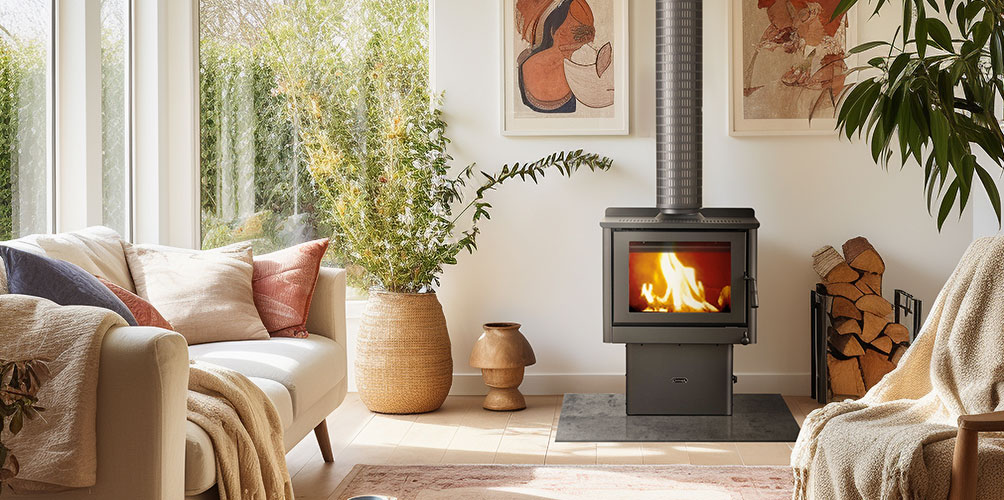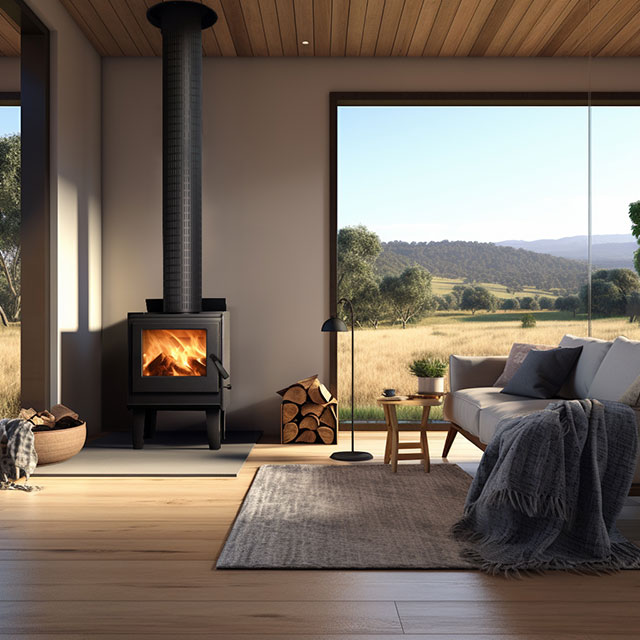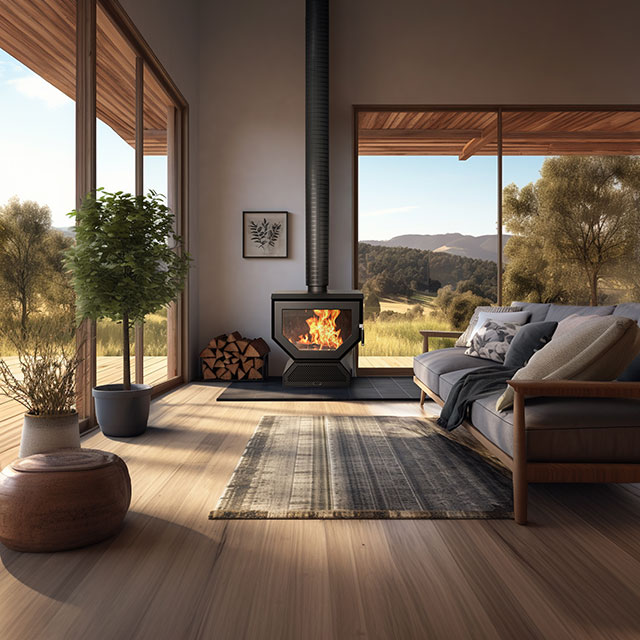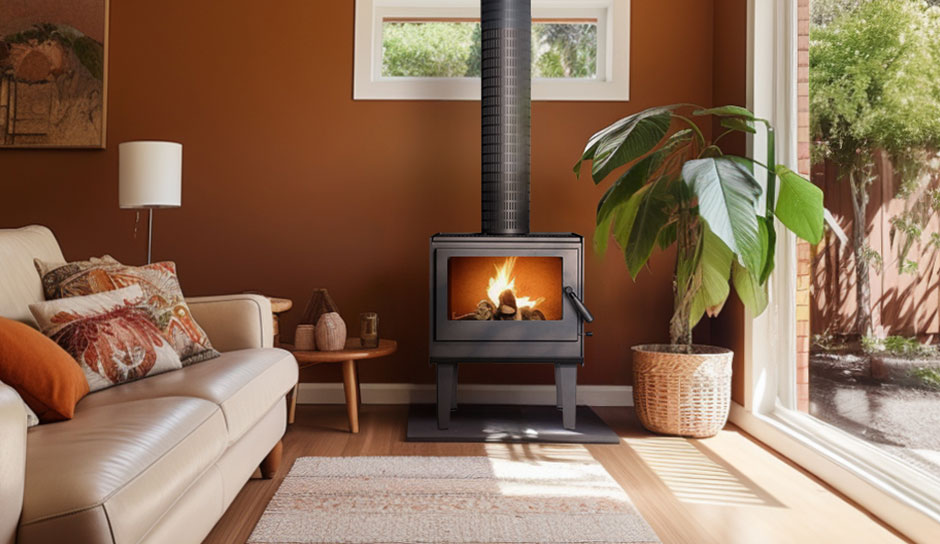With winter always seeming to be around the corner, there’s nothing quite like the comfort and warmth that a wood heater brings to look forward to. In this guide, we aim to walk you through the process of efficiently and safely using your wood heater, ensuring you experience maximum warmth with minimum hassle throughout the chilly season. But why is this your go-to guide for lighting and maintaining your heater? Because our tips for lighting your wood heater are garnered from our Coonara team, the experts in wood heating!
Coonara’s Experience is Unbeatable
Coonara is one of the most trusted names in the heating industry, being proudly Australian-owned and operated. With a legacy of over four decades, Coonara is synonymous with state-of-the-art wood heaters that are not only environmentally friendly but also impeccably designed to fit seamlessly into any living space. Each Coonara wood heater is crafted with precision, offering a perfect blend of style and functionality, making it a preferred choice for homeowners looking for reliable heating solutions.
Our wood heaters are celebrated for their efficiency, performance, and ease of use, providing a cosy ambiance and sufficient heat to keep your entire home warm. Whether you have recently invested in a Coonara wood heater, have a well-loved Coonara and need a refresher, or are considering making a purchase, this guide is designed to assist you in understanding and navigating the features and operations of our esteemed heating products.
And if you don’t have a Coonara, these tips will be just as helpful for making the most of your wood heater.
In the sections that follow, we will delve into the preparation steps, lighting procedures, efficient burning techniques, and essential safety measures to ensure you enjoy a safe, warm, and hassle-free winter with your wood heater.

Wood Heater Preparation Steps
Before you light up your wood heater, a little preparation goes a long way in ensuring an efficient and safe burn. Follow these crucial steps to prepare for a warm and cosy experience:
Choosing the Right Wood
Selecting the appropriate wood is pivotal for efficient heating. Generally, there are two types of woods that you have access to:
- Hardwood: Derived from deciduous trees, hardwoods like red gum, ironbark, box and jarrah are dense and heavy, providing a longer and hotter burn. They are ideal for extended use, like overnight heating.
- Softwood: Coming from coniferous trees, softwoods like pine and cedar burn faster and at a lower temperature. They produce more smoke and creosote that can coat the inside of your flue with resin, increasing risks of blockages and fire hazards.
For your Coonara wood heater, we recommend using only seasoned hardwood for optimal performance and efficiency.
Proper Wood Seasoning and Storage
Seasoned wood is essential for a cleaner and more efficient burn. Wood should be cut, split, and allowed to dry for at least six months to a year. Store your seasoned wood in a dry, covered area with good airflow. Avoid ground contact to prevent rot and dampness.
Preparing Your Wood Heater
A well-maintained heater is key to its longevity and efficiency. Here’s how to prepare your Coonara wood heater for use:
- Cleaning: Regularly remove ash from the heater’s interior, ensuring it doesn’t build up to the loading door’s level. Clean the glass door with a soft cloth or newspaper and a mild cleaning solution suitable for wood heater glass. You can check our expert wood heater cleaning guide for more information. (Insert link to the cleaning guide)
- Maintenance: Inspect the door seals annually to ensure they are intact and secure. Replace worn or damaged seals promptly. Check the baffle plate and firebricks for signs of wear or damage and replace as necessary.
- Chimney Sweep: Have your chimney or flue cleaned professionally at least once a year to prevent creosote buildup, which can lead to chimney fires.
By following these preparation steps, you set the stage for a safe and efficient operation of your Coonara wood heater, ready to bring warmth and comfort to your home.

Lighting the Fire
Igniting your wood heater is a straightforward process, but following the right steps is crucial for a quick, easy, and safe ignition. Here’s a step-by-step guide to help you light your fire efficiently:
Step-by-Step Guide to Lighting Your Coonara Wood Heater
- Open the Air Controls: Start by fully opening the air controls to maximise airflow, facilitating easier ignition.
- Prepare the Firebox: Lay crumpled newspaper or firelighters at the base of the firebox. Place small, dry kindling wood on top, arranging it in a crisscross pattern for better air circulation. Kindling can consist of small, dry sticks from your garden or small splices of hardwood from your wood pile.
- Add Larger Wood: Once the kindling is set, add larger pieces of wood on top, ensuring not to overcrowd the firebox.
- Ignite the Fire: Carefully light the newspaper or firelighters at the bottom. The fire will gradually catch onto the kindling and then the larger wood pieces. You can leave the door open slightly during this stage to allow more airflow to enter the firebox. Do not leave the heater unattended while the door is ajar!
- Add more Wood: Once the fire is going, add one of two larger pieces of wood, gradually building to your largest pieces as the wood heater gets warmer. Do not overload the firebox and leave plenty of room in there for air to circulate. Leaving the air control open fully or at half for a while helps to ignite the larger wood and stops the newly lit fire from smoking too much, which also helps to keep your glass cleaner. Turn on the wood heater’s fan about 30 minutes into the lighting stage.
- Adjust the Air Controls: Once the fire is established, adjust the air controls to regulate the burn rate. A slower burn rate is more efficient and provides longer-lasting warmth. When the fire is going well and outputting sufficient heat, you should be able to turn down the airflow to its minimum setting. Be sure to check on the fire regularly to ensure it is not burning too low or too hot.
Tips for Quick and Easy Ignition
- Use dry and well-seasoned hardwood for easier ignition and efficient burning.
- Arrange the wood loosely to allow adequate airflow, which is essential for ignition and burning.
- Keep the door slightly ajar for the first 10-15 minutes to enhance airflow and facilitate ignition.
Safety Precautions to Consider
- Never use flammable liquids like petrol or kerosene to start the fire, as they pose a significant risk of explosion and fire, as well as emitting harmful fumes into your living space.
- Always wear heat-resistant gloves when handling hot surfaces or logs.
- Ensure there are no combustible materials near the wood heater.
- Keep a fire extinguisher or water source nearby for emergency use.
By following these steps and tips, you can enjoy a hassle-free, safe, and warm experience with your Coonara wood heater.

Efficient Burning for your Wood Heater
Achieving efficient burning is not only about conserving energy and reducing costs but also about creating a comfortable and cosy environment in your home. Here’s how you can ensure efficient burning with your Coonara wood heater:
Controlling Air Intake
Air intake is a crucial factor in the combustion process. Your Coonara wood heater is designed with adjustable air controls that allow you to regulate the amount of air entering the firebox:
- Fully Open: When starting the fire, keep the air controls fully open to allow maximum airflow, facilitating quick and easy ignition.
- Partial Adjustment: Once the fire is established, partially close the air controls to slow down the burn rate. This adjustment helps in maintaining a steady, long-lasting fire while conserving wood.
- Fine-Tuning: Learn to fine-tune the air controls to find the optimal setting that provides the right balance between burn rate and heat output for your specific needs.
Importance of Burning Dry Wood
Dry, seasoned wood is paramount for efficient burning:
- Higher Heat Output: Dry wood burns hotter and produces more heat, enhancing the heater’s efficiency.
- Less Creosote: It reduces the buildup of creosote, a flammable substance that accumulates in chimneys and flues and poses a fire risk.
- Lower Emissions: Burning dry wood results in fewer emissions and smoke, contributing to a cleaner and healthier environment.
Techniques to Maximise Heat Output
- Use Hardwood: Opt for hardwoods like red gum or box, which have higher energy content and provide longer-lasting and hotter fires.
- Load Wood Correctly: Place the logs in the firebox with enough space between them to allow adequate airflow.
- Maintain the Heater: Regular cleaning and maintenance of your Coonara wood heater ensure it operates at peak efficiency. Replace worn or damaged parts as necessary.
By following these guidelines, you can enjoy a warm and inviting atmosphere in your home while ensuring your Coonara wood heater operates efficiently and effectively.

Wood Heater Safety Measures
Safety should be your paramount concern when operating any heating appliance. When i comes to Coonara, your wood heater is designed with safety in mind, but it’s essential to follow these safety measures to ensure a secure and worry-free experience:
Keeping the Area Clear
- Clear Space: Maintain a safe distance between the heater and any flammable materials, including furniture, curtains, and decor. A clear space of at least two metres is advisable.
- Non-Combustible Hearth: Ensure your Coonara wood heater is installed on a non-combustible hearth to prevent the floor from catching fire due to stray embers or intense heat.
- Flammable Essentials: You’ll need things like newspaper, firelighters , matches and kindling to light your fire. However, you must be very careful when it comes to their proximity to your wood burner. Keep igniters like lighters, matches and firelighters in a drawer or cupboard a good distance away, and keep easily combustible kindling outside under cover.
Proper Ash Disposal
- Cool Down: When it comes to cleaning out the firebox, allow the ashes to cool completely before disposal. It’s advisable to let them sit for at least 24 hours to eliminate any risk of smouldering embers.
- Metal Container: Use a metal container with a tight-fitting lid to collect and dispose of ashes. Never use a cardboard box or plastic bin, as they can easily catch fire.
- Safe Disposal: Dispose of the cool ashes in a designated disposal area away from your home and other structures. Avoid dumping them in gardens or compost bins directly, as they may contain live embers.
Regular Maintenance and Inspections
- Routine Checks: Regularly inspect your wood heater for signs of wear or damage. Pay attention to the door seals, glass, and firebricks. Get to know your wood heater and you’ll be conscious of anything that is out of the ordinary.
- Professional Inspection: Have a professional technician inspect and service your Coonara wood heater at regular intervals. They can identify and address potential issues before they become significant problems.
- Chimney Cleaning: Schedule professional chimney or flue cleaning at least once a year to prevent the accumulation of creosote and other residues that can lead to chimney fires.
Adhering to these safety measures will not only extend the life of your Coonara wood heater but also ensure a safe and enjoyable heating experience for you and your loved ones for many years to come.
Conclusion
As we conclude this comprehensive guide, let’s recap the key points discussed to ensure you have a seamless experience with your Coonara wood heater:
- Preparation is Key: Selecting the right type of wood, ensuring it’s properly seasoned and stored, and preparing your heater are crucial steps for efficient and safe operation.
- Lighting the Fire: Follow the step-by-step guide for a quick and easy ignition process, and remember the tips provided to facilitate this process.
- Efficient Burning: Control the air intake, use dry wood, and employ techniques to maximise heat output for an efficient burn.
- Safety Measures: Prioritise safety by keeping the area around the heater clear, disposing of ashes properly, and conducting regular maintenance and inspections.
Your wood heater is designed to provide you with warmth and comfort during the chilly months, and following these guidelines will ensure you enjoy its benefits to the fullest while staying safe.
We encourage you to use your wood heater efficiently and safely. Should you have any questions, need advice on lighting and maintaining a good fire, or require service and maintenance support, don’t hesitate to contact your local Coonara dealer. Our knowledgeable and experienced dealers are always ready to assist you in ensuring that your wood heating experience is nothing short of excellent.
Thank you for choosing Coonara – the warmest Aussie legend!

Frequently Asked Questions
Why is my wood heater not burning hot?
Several factors could contribute to your Coonara wood heater not burning hot. The most common reasons include using wet or unseasoned wood, insufficient airflow due to closed air vents, or a buildup of creosote in the chimney restricting the draft. Ensure you use dry, seasoned wood and maintain proper airflow through the air controls. Regular cleaning and maintenance of your heater and chimney are also crucial. If the issue persists, consult with your local Coonara dealer for expert advice and assistance.
Can I leave my wood heater on all night?
Yes, you can leave your Coonara wood heater on overnight to provide continuous warmth. However, it’s essential to take safety precautions. Use hardwood as it burns slower and longer, fully close the door, and adjust the air controls to slow down the burn rate. Before retiring for the night, ensure there are no flammable materials near the heater and that the unit is functioning correctly. For specific guidance on overnight operation, refer to your Coonara wood heater’s user manual or consult your local dealer.
Should the vents on a wood heater be open or closed at night?
The vents on your Coonara wood heater should be adjusted to a slower burn rate during the night. This usually means fully closing the vents to the minimum level of airflow to reduce the amount of air entering the firebox, which slows down combustion and extends the burn time. However, the vents should not be completely closed if your wood heater has this option, as some air is necessary to keep the fire alive and safe. For precise instructions on vent adjustments, refer to your user manual or contact your local Coonara dealer.
Can I leave the door open on my wood heater?
Leaving the door open on your Coonara wood heater is not recommended, as it allows heat to escape, reduces the efficiency of the heater, and poses a safety risk due to flying sparks and embers. The door should only be left slightly ajar during the initial lighting process to facilitate airflow and ignition, and it should be closed once the fire is established.
What should you not burn in a wood heater?
Avoid burning materials that can cause harm to your health, your Coonara wood heater, and the environment. These include:
- Wet or green wood
- Treated or painted wood
- Plywood or particle board
- Plastic or rubber
- Softwoods like pine
- Garbage or metallic materials
- Driftwood or wood with embedded nails or screws
Using inappropriate fuel can lead to toxic fumes, creosote buildup, and damage to your heater. The rule of thumb is: always and only use dry, seasoned hardwood for the best and safest results.
For any other questions or concerns regarding the operation and maintenance of your Coonara wood heater, your local Coonara dealer is the best point of contact. They possess the expertise and knowledge to assist you in enjoying a warm and safe heating experience.









